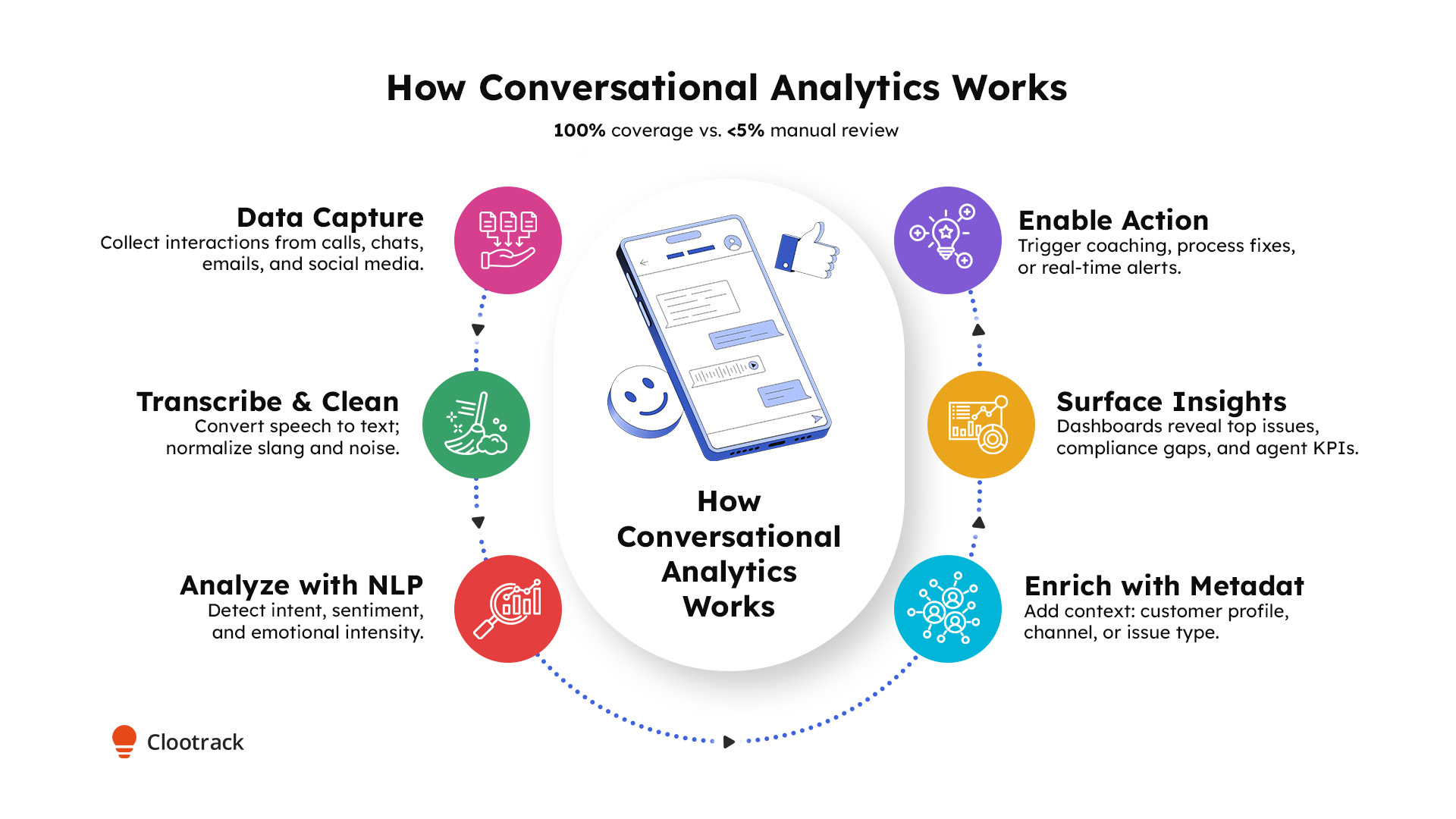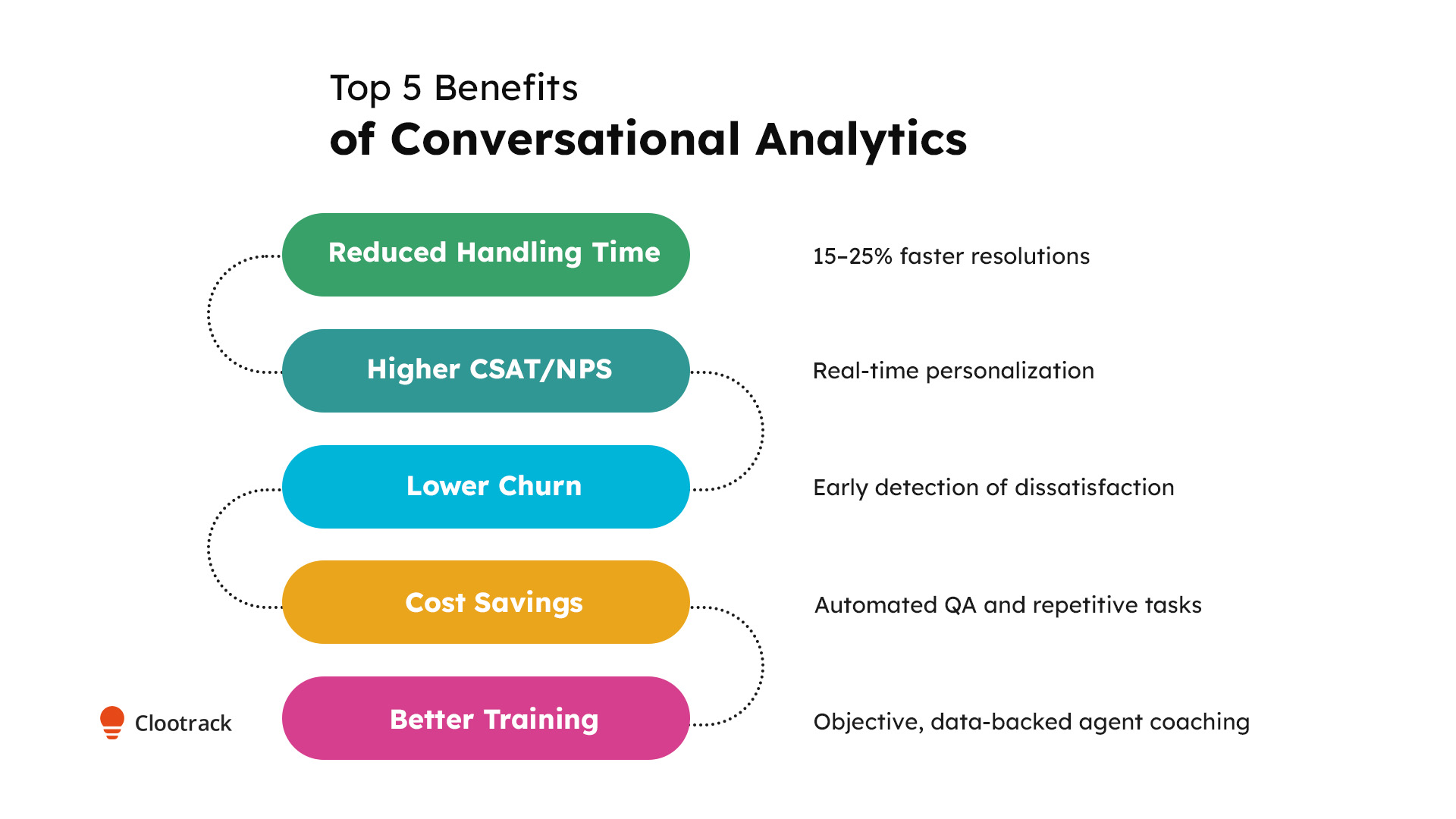In this guide
What is conversational analytics in customer service?

Understanding customer conversations at scale has become essential for modern service teams. Instead of manually reviewing a handful of calls or chats, conversational analytics applies AI to every interaction for consistent and actionable insights.
Conversational analytics is the use of AI and natural language processing (NLP) to analyze customer interactions across channels: calls, chats, emails, or messaging apps.
Unlike keyword tracking or manual sampling, it uses natural language processing (NLP), machine learning, and sentiment analysis to:
- Detect intent, tone, and emotional intensity.
- Identify recurring drivers of contact.
- Surface compliance risks and coaching opportunities.
- Deliver real-time insights back to agents and supervisors.
Why conversational analytics matters in customer service
Customer service operations face two simultaneous pressures: delivering faster, more personalized responses while reducing costs. Conversational analytics bridges this gap by converting unstructured conversations into intelligence that drives efficiency and customer satisfaction.
- Scalability: Manual call sampling covers <5% of interactions; automated feedback analytics tools can analyze 100% in real time.
- Proactive support: Detect dissatisfaction, compliance risks, or churn signals early.
- Cost efficiency: Automates quality monitoring, reduces average handling time (AHT), and improves first-contact resolution.
- Customer experience: Delivers faster, more accurate, and more personalized responses.
How conversational analytics works

The workflow behind conversational analytics combines data capture, linguistic analysis, and reporting. Each stage turns raw, unstructured input into a structured view that service teams can actually act on. Here’s a breakdown:
- Data capture: Collecting data from voice, chat, email, and social platforms to unify every customer interaction in one stream.
- Transcribe and clean: Converting speech to text, normalizing slang, spelling, and noise to ensure clean, analysis-ready data.
- Analyze with NLP: Extracting intent, detecting topics, and measuring sentiment to uncover tone, urgency, and emotional intensity.
- Enrich with metadata: Adding customer profile, interaction history, and channel type to give each insight business context.
- Surface insights: Visualizing trends, agent performance, and compliance gaps for 100% coverage vs. <5% manual review.
- Enable action: Using insights to coach agents, update knowledge bases, and trigger real-time improvements.
Benefits and ROI of conversational analytics
When applied effectively, conversational analytics impacts both the customer and the bottom line. The ROI is measurable across service speed, satisfaction, and operational costs.
Here’s how VoC intelligence translates to faster resolutions and happier customers:
- Reduced handling time → Enables 15–25% faster resolutions, improving both efficiency and customer satisfaction.
- Higher CSAT/NPS → Driven by real-time personalization, ensuring every interaction feels relevant and timely.
- Lower churn → Achieved through early detection of dissatisfaction, allowing proactive intervention before customers leave.
- Cost savings → Delivered by automating quality checks and repetitive tasks, freeing teams to focus on higher-value work.
- Better training → Supported by objective coaching for agents, improving performance consistency and overall service quality.

Key use cases in customer service
The true value of AI-powered conversational analytics comes from its application. By uncovering themes across thousands of conversations, it empowers service leaders to improve both agent performance and customer outcomes.
- Agent coaching and performance monitoring.
- Detecting churn signals and dissatisfaction.
- Automating repetitive queries with chatbots.
- Improving compliance and quality assurance.
- Feeding insights into product and process improvements.
- Predictive feedback analytics: spotting early signals of customer frustration before it escalates.
AI-powered contact center analytics platform
Common challenges
Like any AI-driven initiative, conversational analytics comes with hurdles. These challenges often appear during early adoption and can be mitigated with the right practices.
- Accuracy issues with slang, dialects, or multilingual inputs.
- Maintaining context in multi-turn conversations.
- Compliance risks from sensitive data in transcripts.
- Resistance to adoption from agents/managers/
Mitigation: Choose domain-tuned NLP, anonymize sensitive data, implement human-in-the-loop oversight, and roll out with clear KPIs.
Best practices for implementation
Success depends not only on technology but also on clear objectives and disciplined rollouts. Teams that set measurable customer experience KPIs and integrate feedback analytics into workflows see the strongest results.
- Define measurable goals (CSAT, FCR, churn reduction).
- Start with one channel (e.g., call center) before scaling.
- Ensure clean, centralized data pipelines.
- Integrate analytics with existing CRM or service platforms.
- Regularly retrain models for accuracy and fairness.
Bottom line
AI-powered conversational analytics turns raw customer interactions into structured intelligence. In customer service, it helps leaders cut costs, elevate CX, and anticipate risks: delivering measurable ROI when implemented with clear goals and robust governance.
FAQs
Q: What is customer service analytics?
Customer service analytics is the practice of collecting and analyzing data from customer interactions (calls, chats, emails, tickets, and surveys) to evaluate service performance and customer experience. It tracks metrics such as response time, resolution rates, CSAT/NPS, and churn signals.
Q: Is conversational analytics just sentiment analysis?
No. Sentiment analysis is one element. Conversational analytics covers sentiment, intent, compliance, themes, and predictive insights.
Q: What KPIs improve with conversational analytics?
First-contact resolution, CSAT/NPS, average handling time, agent productivity, and churn rate.
Q: How secure is conversational data?
Leading platforms anonymize transcripts, comply with GDPR/CCPA, and restrict access with role-based permissions.
Q: How accurate are intent and sentiment detection models?
Accuracy depends on training data, fine-tuning for domain-specific terms, and preserving multi-turn context. It’s best to monitor accuracy continuously and keep a human-in-the-loop in early stages.
Q: Does conversational analytics work with multilingual interactions?
Yes, but accuracy varies by language. Models trained on regional dialects and slang deliver better results. Clootrack AI for example supports over 55 global languages.
Do you know what your customers really want?
Analyze customer reviews and automate market research with the fastest AI-powered customer intelligence tool.




